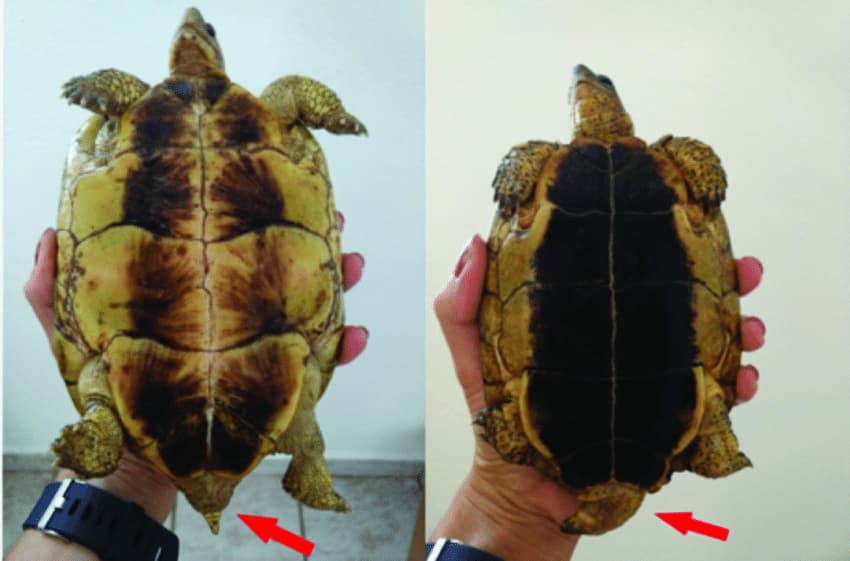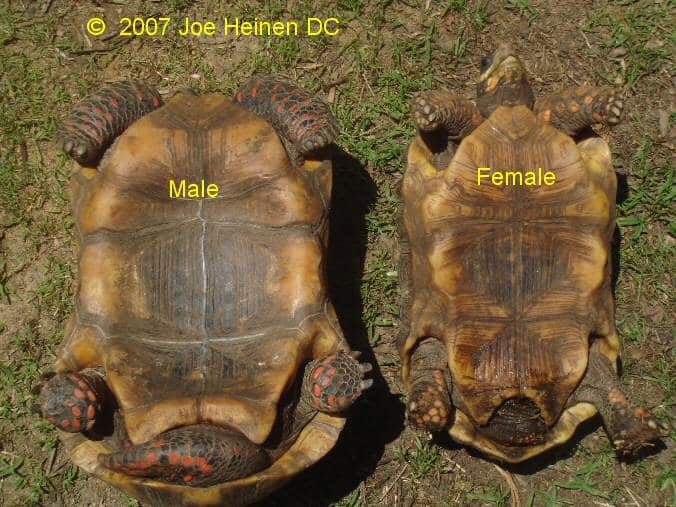Tortoises are fascinating reptiles.
They live in the wilderness, have big shells, and can live to be a hundred years old! But do tortoises have tails? It might seem like an easy question at first, but there is more than one answer.
The answer is actually yes. Unlike their quick-moving cousins (Turtles), tortoises are not born with a tail. They grow their tails as they age.
The easiest way to determine the gender of your tortoise is to check its tail length. Male tortoises have long tails, and females have much shorter tails.

Pointing in a different direction from the body, female tortoises exhibit a pointed, dropped tail. Males’ tails stick up at an angle from the rear shell.
Their slow pace and ability to live a long life make them ideal pets for many people.
In the wild, they can live for up to 100 years old. But if you’re planning on getting a tortoise as a pet, here are some things you need to know.
Do All Tortoises Have Tails?
All tortoises have tails.
When I ask the question, “Do all tortoises have tails?” the only rational answer is yes.
I don’t think a single person would answer no to this question because it’s obvious that all tortoises have tails.

How Long is a Tortoise’s Tail?
One of the most frequent questions asked by kids who visit schools, colleges, and museums is, “How long is a tortoise’s tail?”.
Kids would love to know the measurement of a tortoise’s tail. And they would be happy if someone could answer their question.
People answer about how long a tortoise’s tail is. It really depends on the type of tortoise and what it’s being used for.
They can use their tail for defense, to walk, in mating rituals, to store fat, and as a hook to grab food, among other things.
What Else Can You Tell From the Length of a Tortoise’s Tail?
Well, for one thing, it can be used to determine its age.
Another fact is that while broad-tailed species of tortoises generally have short tails, those that live in high altitudes or rocky areas may have noticeably long tails.
The tortoise’s tail is a characteristically long appendage that has been discovered to show various telltale signs that reveal information regarding the health of the animal.
Interestingly, this ‘characteristic’ goes against what would be considered ‘logical,’ as it is not natural for the in-vogue natural selection process to select traits and characteristics such as these.
The length of this tail can provide information on several aspects of the tortoise’s body, including the spine, liver, intestines, and kidneys.
In fact, several scientific studies have found that animals with longer tails tend to live longer than their shorter-tailed counterparts.
Why Do Tortoises Wag Their Tails?
To urinate, tortoises wag their tails to direct the stream of urine to the precise spot.
In the wild, a tortoise must conserve water since they live in an arid climate.
To accomplish this, they point their tails downward and spray straight forward, allowing only a minute amount of urine to exit.
Out in the wild, a male tortoise will aim his bottom toward her head while she moves her head so that both animals end up facing each other.
What is the Difference Between Males and Females?
The Answer Is more complicated than you might think.
In the world of tortoise keeping, I have noticed a lot of talk about male and female tortoises.
There is a lot of confusion as most people think that both males and females are identical in appearance.
That is not true. Tortoises have separate male and female tortoises.
The size of male tortoises tends to be larger than that of females. Males also have concave plastrons, while females have flat plastrons.
In addition, the tail of the male is longer in relation to the body than it is with females.

How To Determine The Gender Of Your Tortoise?
To determine the gender of your tortoise, a quick check of the rear shell is a good first step.
A pet store will usually have a galvanized tub or vivarium on hand to check the tortoise’s tail length, which is written on the band that encircles the tail.
A turtle or tortoise keeper is also more likely to have a bigger vivarium than a pet store.
They may ask to take your tortoise or tortoise keeper to a small room with a scale to weigh it.
Mysteries With Tortoise or Tortoise Keeper Pee-Pee, One of the strangest pet peeves among owners, is when their tortoise relieves itself anywhere other than its home, water, or other designated areas.
My female Galapagos tortoise, Nadia, uses a corner of the floor for the purpose.
